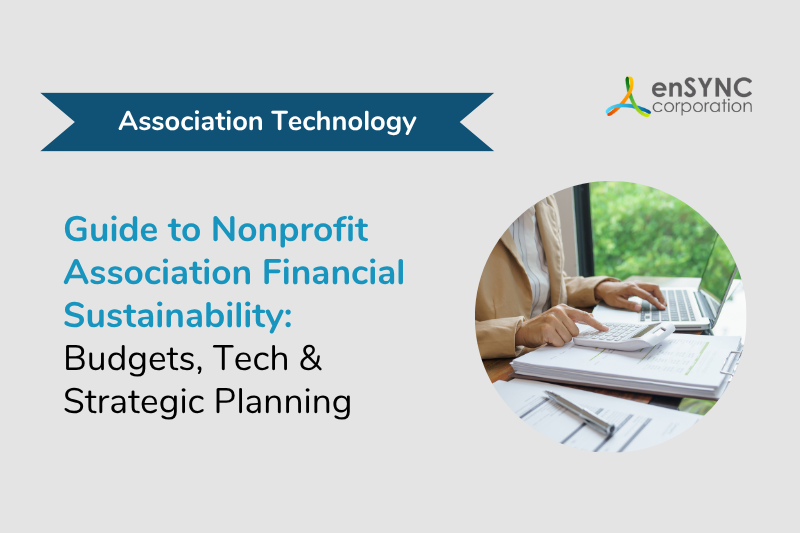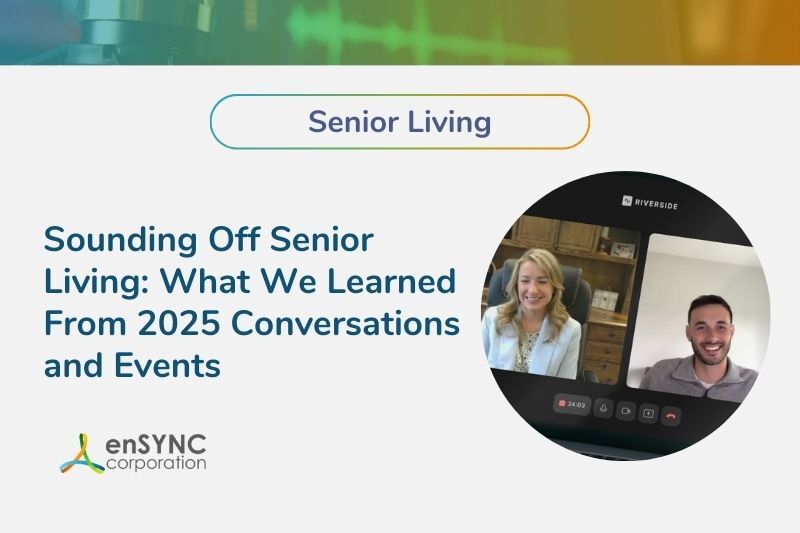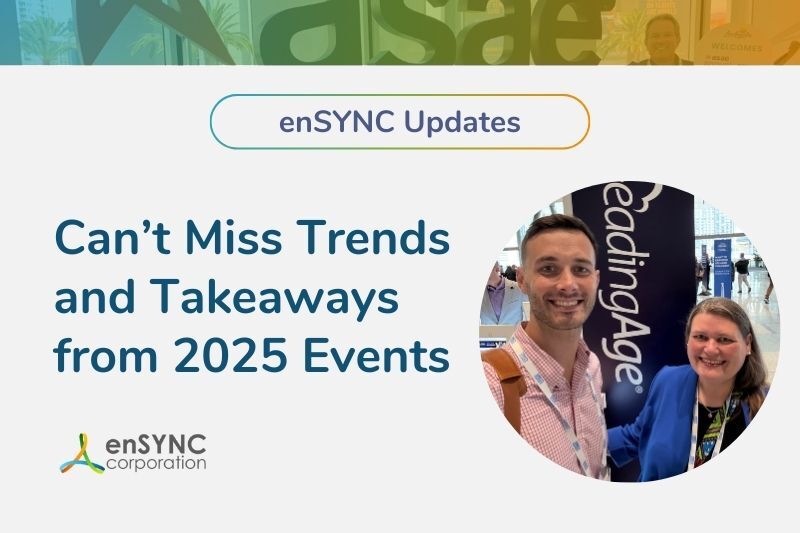Nonprofits & associations | Financial management
Guide to Nonprofit Association Financial Sustainability: Budgets, Tech & Strategic Planning
August 11, 2025
|
Trade and member associations play an important role, providing members with education, networking opportunities, research, and advocacy — fostering community around a shared mission. Many associations are either 501(c)(3) or 501(c)(6) nonprofit organizations. But just because they do not set out to produce a profit, associations must achieve funding and financial sustainability to weather unexpected storms and fulfill their missions.
Table of Contents
- What Is Nonprofit Association Financial Sustainability?
- The Role of Strategic Planning in Financial Sustainability
- Creating and Managing a Nonprofit Budget
- Financial Sustainability Through Non-dues Revenue
- Using Nonprofit Technology to Strengthen Finances
- Bringing It All Together: Strategy + Budget + Tech = Sustainability
What Is Nonprofit Association Financial Sustainability?
A nonprofit association with financial sustainability can not only cover its operational costs and deliver its valuable services and programming but also has enough cash reserves for unexpected emergencies. While the exact amount needed in reserves is specific to each association, the general rule of thumb is three to six months’ worth of expenses in reserves.
According to the American Society of Association Executives (ASAE) 2022 report “Association Investment Policies, Practices, and Performance,” 63% of associations hold reserves equal to or greater than 50% of their annual operating budgets. In addition, 37% maintain reserves of 100% or more, with larger organizations more likely to have these high amounts than smaller ones.

Financially sustainable associations can focus on their mission rather than worry about how they will cover the next month’s expenses. According to AMR Management Services, an association management company, sufficient reserves enable an association to:
- Prevent budget cuts when addressing drops in revenue or unexpected expenses
- Fund new programs before they are financially sustainable
- Provide funding for one-off projects
The Role of Strategic Planning in Financial Sustainability
Without a strategic plan in place, it can be hard for associations to forge ahead and successfully bolster their financial reserves.
Nonprofit association strategic planning allows organizations to articulate their vision and identify ways to efficiently use resources as they achieve their mission. This important exercise should be reviewed annually, decreasing overall organizational risk and supporting financial sustainability.
“By taking the time for thoughtful strategic planning, which includes budgeting and forecasting for unexpected variables, an association can be sure they are working toward their goals and maintaining financial stability for the organization,” says Chadd Arthur, Vice President, enSYNC. “We typically recommend nonprofit associations maintain a flexible one-year plan to stay on track.”
Key Components to Successful Strategic Planning
- Situation assessment through analysis of current internal strengths, weaknesses and opportunities, as well as external factors that may impact your organization.
- Vision and mission development to keep values, purpose, and future planning at the forefront.
- Setting strategic priorities and goals to set benchmarks and track financial performance over time.
- Documentation of your plan, mission, and goals for full team and stakeholder buy-in.
- Implementation and optimization over time through continuous monitoring against your defined strategic plan.
Creating and Managing a Nonprofit Budget
An important step in strategizing for financial sustainability is budgeting. According to the Wallace Foundation, a budget is simply your “organization’s strategy expressed in dollars.” Without a clear picture of your projected expenses and income, it's hard to implement your strategy efficiently.
An operating budget for an association is the main financial plan, outlining the core financial elements:
- Expenses, such as payroll, benefits, programming, and events costs, among others
- Projected revenue, from sources such as grants, fundraising, donations, etc.
- Forecasted cash flow, to get a full picture of where money comes in and goes out at your organization
Knowing your organization's expenditures and gains will allow you to identify opportunities for creative savings and efficiencies.
Questions to Ask When Creating a Mission-Aligned Budget
As you compile and evaluate your budgetary numbers, some questions can be valuable for your budget team to discuss:
- What current debts does our organization have?
- What are our income sources?
- What is the minimum amount of money we need monthly to fund our organization?
- How much does it cost to cover team and office expenses?
- Do we have money in reserves? How many months could it sustain our organization?
- What are our priorities (expanding services, new offerings, etc.) if we had the available funds?
Examples of Association Budgets and Templates
If you’re ready to get your financial plan in working order, there are plenty of customizable nonprofit budget templates available online, allowing you to tailor them to your organization’s specific needs.
Choosing a customizable budget template is advantageous for small and mid-sized organizations. It can be modified and scaled to grow alongside your association, adding any new program costs, departments, or revenue sources without having to recreate the entire process.
Download enSYNC's Association Operational Budget Template
Financial Sustainability Through Non-dues Revenue
Non-dues revenue is an essential component of a financially sustainable nonprofit association strategy — particularly for organizations that rely heavily on membership dues. Membership fees might provide baseline income, but they often fall short of funding expanded operations, new programs, or maintaining a healthy reserve. Developing a sound non-dues revenue strategy allows nonprofits to reduce reliance on a single source and achieve financial sustainability.
According to ASAE, non-dues revenue accounts for as much as 70% of total revenue in some organizations, underscoring just how critical this funding source is for modern nonprofits and associations.
What Is Non-dues Revenue?
Non-dues revenue refers to any income generated outside of traditional membership dues or fees. This can include educational offerings, events, consulting, product sales, media, and more. When structured thoughtfully, these revenue streams not only support financial health but also advance mission impact.
Why Do Associations Need Non-dues Revenue?
Associations that have a diversified income stream, including non-dues revenue, protect themselves from disruptions or declines in membership. “Associations’ non-dues revenue streams provide flexibility, cushion against economic or membership fluctuations, and present new possibilities for engagement,” Arthur says. “This financial cushion from non-dues revenue also reduces the pressure to increase dues or cut programs — two options that can weaken member relationships over time.”
Beyond greater financial stability, non-dues initiatives — particularly those involving education, events, or consulting — can deepen member engagement, expand audience reach, and establish the association as a thought leader within its field. A well-designed non-dues portfolio strengthens the brand, drives relevance, and can even bring in new partners or funders.
Ideas for Non-Dues Revenue Streams
A variety of non-dues revenue sources can seamlessly align with an organization’s mission, bringing added value and income. Below are common types of non-dues revenue.
Educational Offerings
Providing professional development opportunities is one of the most effective — and sought-after — sources of non-dues revenue. According to the 2025 Membership Marketing Benchmarking Report, almost 40% of associations cited continuing education as a primary reason for members joining their organization. Types of non-dues educational products and services include:
- Online Courses and Certifications: Offer recorded or live courses tied to specific industry trends and skills or credentialing pathways.
- Webinars, Virtual Workshops, and In-Person Seminars: Host fee-based sessions that deliver timely, expert-led learning experiences.
- Content Licensing: Package and license educational materials for similar organizations to use. One example is the Education Partner Program through the Society for Human Resource Management (SHRM). SHRM creates a wide range of educational content and shares it with corporate HR departments, universities, training firms, and other entities.
Events
Another member favorite, events and conferences create valuable educational and networking opportunities for members and sponsors. Think beyond the annual conference with events such as:
- Ticketed Networking Events or Speaker Series: Curated for community building and thought leadership.
- Trade Shows or Industry Expos: Offer booths, branding, and lead generation opportunities.
- Hybrid Events: Expand participation for all members by combining live and virtual components.
Publications and Advertising
Chances are, your association is already creating tons of great content, from physical magazines to digital reports to newsletters. These are brimming with opportunities to create non-dues revenue. Examples include:
- Sponsorships and Advertising: Sell ad space or offer sponsored content opportunities in your email communications and digital or print magazine. These opportunities enable sponsors or advertisers to reach their target audience while providing valuable resources to association members. The Wisconsin EMS Association (WEMSA) saw impressive results through a creative sponsorship program. They established partnerships with vendors that supply equipment to their members and implemented a rebate program. When a member purchased from a participating vendor, WEMSA earned a percentage of the sale, creating a steady stream of non-dues revenue. These partnerships — along with renting out office space and surplus parking — increased WEMSA’s non-dues revenue by 49% year over year.
- Reports, eBooks and Guides: Sell or license downloadable resources filled with your association’s expertise.
- Podcast and Video Opportunities: Offer sponsorship opportunities, co-branded episodes, or gated bonus content for paying audiences.
Merchandising and Branded Goods
Branded merchandise offers revenue and brand visibility for both members and supporters. For example, the American Library Association’s online store sells books, bookmarks, bags, and more — many emblazoned with their simple message: “Read.” Your association can also sell apparel, accessories, and other swag featuring your logo, mission statement, or slogans relevant to members. For an in-person twist, your association could host a pop-up shop at your annual conference or other events, offering limited-edition goods to build hype and generate non-dues revenue.
Fundraising Campaigns & Donor Engagement
501(c)(3) associations can diversify their revenue through targeted fundraising efforts such as annual giving campaigns, special events, peer-to-peer outreach, and recurring donor programs. These initiatives — often supported through social media and email marketing — leverage both broad community support and personal networks. Opportunities for corporate sponsorships and matching gifts can further amplify impact while building strategic partnerships.
Facility and Asset Rental
Do you have physical space or equipment that is sitting unused at times? Consider renting it out for increased income. This could include full meeting rooms for events or office space and desks for coworking. This option is especially valuable for associations with permanent offices or training facilities.
Tips for Implementing Non-dues Revenue for Financial Sustainability
- Start Small and Refine: Pilot one or two non-dues revenue initiatives, measure success, and scale accordingly.
- Know Your Audience: Align offerings with the real needs and preferences of your audiences rather than giving in to trends.
- Track ROI and Satisfaction: According to the U.S. Chamber of Commerce, non-dues revenue initiatives should aim to at least double the return on investment. Beyond revenue, evaluate how initiatives impacted engagement and the overall perception of your organization.
- Balance Mission with Revenue: Every initiative should advance your organizational purpose, not distract from it.
A well-executed non-dues revenue strategy not only financially secures your organization but also deepens your bond with members and advances your mission.
Using Nonprofit Technology to Strengthen Finances
With the plethora of options available, associations are increasingly turning to financial technology (FinTech) solutions to manage finances, streamline operations, and amplify their impact. According to Sage Intacct’s 2024 Nonprofit Technology Trends Report, nearly 300 leaders from nonprofits — including small to mid-sized trade and member associations — highlighted the pivotal role of technology in achieving mission-driven goals.
“Our findings emphasize the critical role of association finance leaders in leading their organizations through change with transparency, accountability, and strategy,” the report states. “As nonprofit associations face a complex landscape, the ability to track outcome metrics, strengthen financial planning, and enhance operational efficiency is crucial for long-term sustainability and impact. With critical challenges such as economic uncertainty, inflation, and competition for funding at the forefront of the nonprofit sector, the need to leverage modern technology solutions is greater than ever.”
The Benefits of Modern Financial Tools for Nonprofit Associations
The latest financial tools on the market offer associations several advantages:
- Improved financial administration: Automating bookkeeping, payroll, and reporting reduces human error and lightens the load for your team (and budget).
- Increased productivity: Cloud-based tools enable real-time collaboration and give you access to financial data from anywhere.
- Enhanced transparency and compliance: Built-in compliance tracking, audit trails, and customizable reporting features keep you accountable.
- Elevated donor engagement: Digital platforms simplify giving processes, improving donor experiences and retention.
“Modern financial tools are no longer a luxury for associations; they're a necessity,” says Arthur. “Today’s platforms give association leaders the clarity and control they need to make mission-driven decisions and operate with confidence. When systems are built to support transparency, automation, and real-time insights, organizations can pivot quickly, maximize limited resources, and focus on delivering impact.”
Numerous cloud-based nonprofit accounting software solutions are now available that facilitate all aspects of financial management with features that include:
- Accounting
- Budgeting and forecasting tools
- Grant management features
- Customizable dashboards, financial statements, and drill-down reports
- Integration and automation features
Choosing the Right Accounting or Budgeting Software
With so many nonprofit association technology tools on the market, finding the right option can seem overwhelming. Keep in mind these tips when shopping around for finance software for associations:
- Define organizational needs: Identify requirements such as donor tracking, grant management, payroll integration, or multi-entity support.
- Evaluate scalability: Choose nonprofit computer software that can grow with your organization.
- Assess integration capabilities: Ensure compatibility with existing CRM, fundraising tools, and reporting systems.
- Review support and training options: Opt for vendors offering association-specific training and ongoing support.
While each platform has its strengths and limitations, it’s crucial to select a system that supports financial reporting in line with Generally Accepted Accounting Principles (GAAP) or International Financial Reporting Standards (IFRS) guidelines.
Best Practices for Using Association Tech to Save Time and Money
As tempting as it is to “set it and forget it” with technology, association professionals will get the most out of their technology and decrease the risk of errors when they follow some simple best practices:
- Automate recurring transactions, reducing manual entry and minimizing errors
- Utilize dashboards and real-time reporting, which inform decision-making with up-to-date financial data
- Invest in staff training, maximizing return on investment by ensuring staff are proficient with new technologies
- Conduct regular tech stack reviews, and identify and eliminate redundancies to streamline operations

Popular Nonprofit Tech Platforms for Finance Teams
Various financial technology solutions are available for associations to leverage according to their unique needs. Here are some of the most impactful:
- Online payment processing systems: Platforms like Laurel and CardPointe facilitate seamless payments, donations, and recurring payments.
- Mobile banking and digital wallets: These tools offer quick access to funds and flexible financial management.
- Financial software and accounting tools: Solutions like QuickBooks Online, Sage Intacct, and financeSYNC provide specialized features tailored to association financial management.
Bringing It All Together: Strategy + Budget + Tech = Sustainability
Achieving long-term sustainability requires a harmonious alignment of strategic planning, budgeting, fundraising, and technology. When these components work in concert, associations can transition from reactive crisis management to proactive, mission-focused growth.
According to the 2025 Nonprofit Technology Impact Report, prioritizing financial management systems that free up finance teams to contribute strategic insights is essential for sustainable mission growth.
Example Scenarios of Sustainable Nonprofit Operations
Nonprofits — from trade and member associations to nonprofit organizations — that formulate their strategic plans and implement the technologies best suited to them enjoy long-term sustainability and organizational security.
Case Study: The Seattle Indian Health Board
The Seattle Indian Health Board (SIHB), a 501(c)3 health organization, set out to implement a more scalable and transparent nonprofit accounting software to effectively manage its complex financial information. A large portion of their funding comes from grants. SIHB implemented Sage Intacct, a cloud-based software and saw immediate benefits, including:
-
An 80% boost in revenue
-
Easy access to data
-
Quarterly reports generated in 40 minutes
-
Reduction in the monthly close cycle, from two months to three weeks
The scalable and transparent accounting software allowed SIHB to manage funds more effectively, ensuring long-term financial sustainability.
Tips to Move From Reactive to Proactive Financial Management
Moving from reactive to proactive in finances takes a patient approach. As you create your strategy and budget and implement your technology, here are some final tips to help you increase your association’s financial sustainability.
- Conduct regular financial health assessments: Identify areas for improvement and track progress over time.
- Create cross-functional teams: Involve finance, programmatic departments, and IT to foster collaboration and all-hands-on-deck decision-making.
- Maintain a living strategic plan: Flexibility is key. Adapt to new insights and funding landscapes by keeping plans malleable and up-to-date.
- Prioritize ongoing training: Keep your team in the know as you cultivate a culture of tech adoption and financial sustainability.
“Sustainability isn’t just about financial stability; it's about creating an ecosystem where strategy, budgeting, and technology harmonize to drive mission success,” Arthur says. “By embracing modern financial technologies and aligning them with strategic planning and budgeting, nonprofit associations can enhance operational efficiency, increase transparency, and lay the foundation for long-term sustainability.”
Are you ready to see if your technology meets the needs of your association?
Take our tech quiz and find out.

Meet Josh Kozinski, the Director of Business Development at enSYNC. With expertise in Sage Intacct, iMIS, and supporting technologies, Josh’s mission is to simplify complex processes by transforming rogue spreadsheets and databases into streamlined, automated solutions. His dedication to delivering strategic solutions aligns perfectly with enSYNC’s commitment to efficient and innovative nonprofit management. Josh is not just a leader at enSYNC; he’s actively involved in prominent industry organizations. By staying connected with these networks, Josh remains at the forefront of industry trends and best practices. In addition to his professional pursuits, Josh serves on the Membership Committee for the Dallas Fort Worth Association Executives, giving back to the industry he’s passionate about. Away from the office, Josh is an athlete at heart. He pursued his college education at Central Michigan, where he played basketball. However, what Josh values most are his relationships with his family and his faith in God. Josh is always open to discussions, whether you’re seeking innovative solutions for nonprofit management, exploring industry trends, or simply connecting with like-minded professionals.
Recent Posts

The Best of the Blog 2025 — A Year in Review
From forward-looking trend analyses to powerful case studies and thought-provoking conversations, the enSYNC blog featured a host of great content in...

Sounding Off Senior Living: What We Learned From 2025 Conversations and Events
As senior-living leaders navigate 2025’s rapid shifts in workforce, technology, regulation, and resident expectations, one theme has become...
Enjoying our blog?
At enSYNC, we want to empower associations and nonprofits to make well-educated decisions. If you want our industry knowledge (and other free guides) sent directly to your inbox, fill out the form below.

